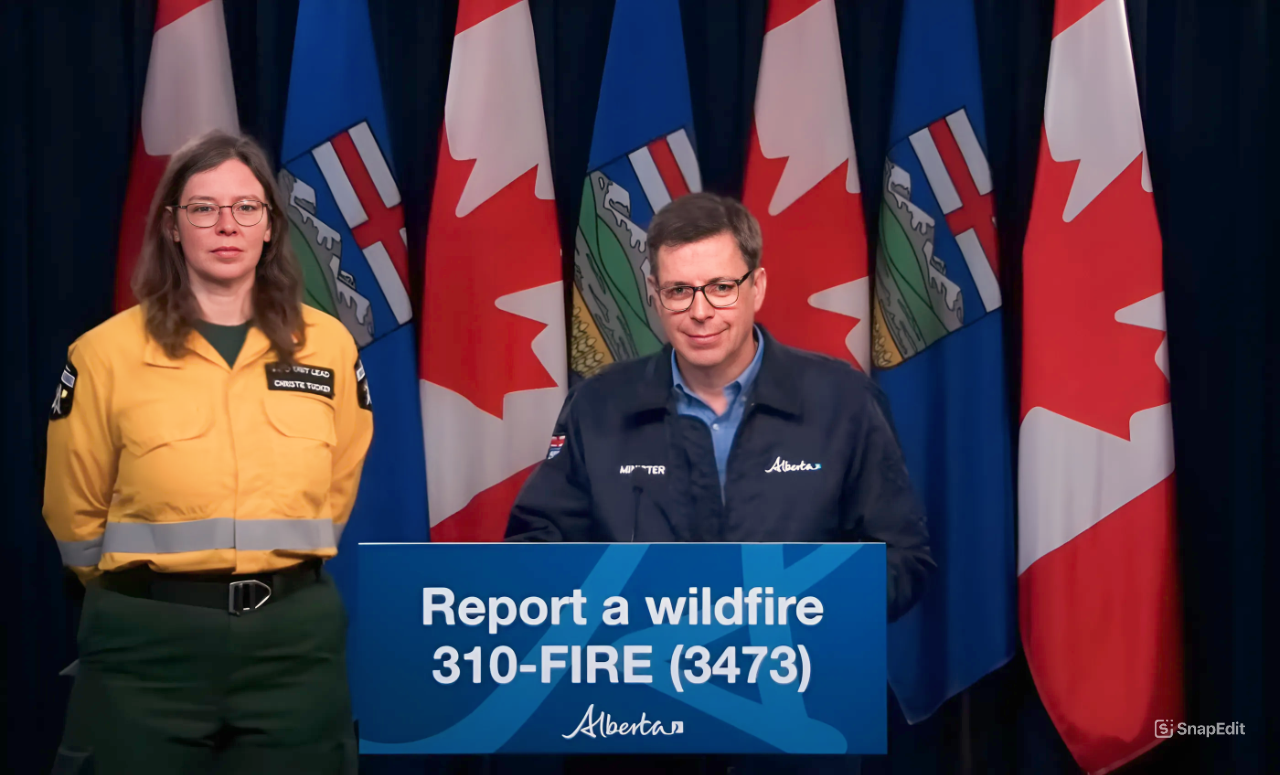Minister of Forestry and Parks, Todd Loewen, provided a detailed update on Alberta’s wildfire situation during a weekly briefing on May 29, 2024. Joined by officials from Alberta Wildfire and the Alberta Emergency Management Agency (AEMA), Minister Loewen addressed the province’s current wildfire status, preventive measures, and ongoing firefighting efforts.
Minister Loewen began by noting that a wildfire which started in the Northwest Territories last year and spread to Northern Alberta remains out of control. Despite this classification, he reassured the public that the situation is under joint management by Alberta and Northwest Territories authorities.
“A new wildfire was detected in the Calgary Forest Area early this morning,” Loewen said. “It is currently two hectares in size, and surrounding communities in the Ghost River area may see smoke. We have firefighters and aircraft actively responding to this wildfire.”
Loewen highlighted the success of Alberta’s prevention and response strategies this season. Compared to last year’s 540 wildfires burning 1.3 million hectares by this time, the province has seen just over 380 wildfires with under 28,000 hectares burned so far this year.
“This is encouraging, but it’s important to remember that we’re still in the early stages of the wildfire season, and conditions can change quickly,” he cautioned.
Recent lightning storms have impacted wildfire activity across the province. “Up until last week, Alberta had only one lightning-caused wildfire. However, in recent days, six new wildfire starts have been confirmed as lightning-caused,” Loewen said.
Given the unpredictability of lightning-caused wildfires, Loewen emphasized the importance of preventing human-caused fires to ensure that resources can be focused on naturally occurring wildfires. “The best thing we can do is to make sure our Wildland firefighting teams have ample capacity to combat them,” he noted.
Responding to questions about improved strategies, Minister Loewen attributed this year’s better outcomes to several key changes:
Earlier Start to the Wildfire Season: Crews were prepared earlier, allowing a prompt response to wildfires.
Increased Manpower and Equipment: The province hired additional crews and contracted two extra air tanker groups.
Night Vision Technology: The introduction of two night vision helicopters and the capability to fight wildfires at night has made a significant impact.
“These advancements, coupled with strategic planning, have greatly improved our ability to manage wildfires effectively,” Loewen stated.
Christie Tucker, Information Unit Manager for Alberta Wildfire, provided a more granular look at the current wildfire situation. “There are currently 26 wildfires burning in the forest protection area of Alberta. Two are being held, one is out of control, and the rest are under control,” Tucker reported.
She reiterated the positive trend compared to last year, attributing it to the weather and the efficiency of response teams. Tucker highlighted that Fort McMurray has seen the most significant wildfire activity, with nearly 27,000 hectares burned from 27 wildfires.
“May is always a time of higher wildfire danger here in Alberta,” Tucker explained. “The greatest indicator of what kind of season we’ll have is usually the spring rain, and we’re grateful for the rain we’ve had over the past couple of weeks.”
In response to a query about the investigation of human-caused wildfires, Loewen explained the process. “All our wildfires in Alberta are investigated. If there’s any indication of malice, the information is passed to the RCMP.”
The Minister also addressed the province’s aerial fleet capabilities. Alberta has expanded its air tanker fleet and is exploring further investments in both air tankers and helicopters. Currently, the province contracts helicopters as needed, with significant capability already in place through private industry.
The briefing concluded with an emphasis on the importance of public awareness and safety. “I want to encourage everyone to download the Wildfire app, the fire ban app, and the emergency alert app for the most up-to-date information,” Loewen urged.
With the wildfire season in its early stages, the province remains vigilant. “Conditions can change rapidly, and we are prepared to adapt our strategies as needed,” Loewen affirmed.

